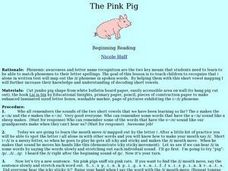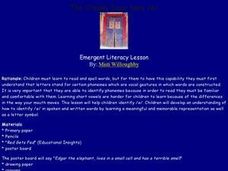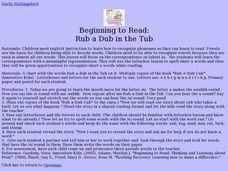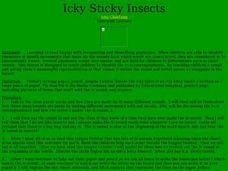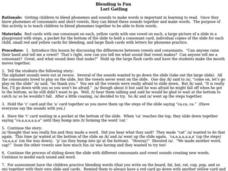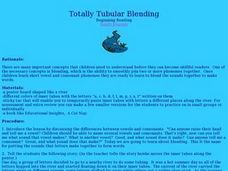Curated OER
Growing Seeds
In this science worksheet, students read 5 different scenarios with varied growing conditions for plants. Students make a prediction for each: Will it grow a little, grow a lot, or not grow at all?
Curated OER
The Pink Pig
Students identify the short /i/ sound in spoken words and the letter symbol in this lesson. They say a tongue twister emphasizing words with the short /i/ sound. They then read the story "Liz is Six" and identify the words with the...
Curated OER
"Whaaa" Said The Baby"
Students recognize phonemes that correspond with the letters in the alphabet. They focus on identifying the short a, /a/ sound. They examine the way their mouths move when making the short a sound mimicking a baby's cry. In given...
Curated OER
ADULT ESOL LESSON PLAN--Family and Parenting
Pupils explore all the specific requirements that must be followed in order to enroll children in school/day care aged 6-16. In addition, they review the importance of regular school attendance.
Curated OER
ADULT ESOL LESSON PLAN--Level 2--Transportation and Travel
Students explore all the possible options and benefits of transportation/travel within the United States. An extensive list of options is listed for them within a vocabulary list on the board.
Curated OER
The Creaky Door says /e/
Students explore the short /e/ sound, and identify the short /e/ in writing. Students read fun sentences from the board which emphasize the short /e/. They stretch out the /e/ sound every time they come to it while reading. They then...
Curated OER
Ashley's Apples
First graders compare the /a/ sound to that of a baby crying. They practice making the sound and then say the tongue twister as it is written on a sentence strip and then using the overhead and letters, name words with that sound in them.
Curated OER
The Icky Sticky Igloo
Students focus on the correspondence i=/i/. They explore the sound and spelling of /i/ and discover vowels are used to spell all words in our vocabulary, so therefore it is important for students to understand the phoneme and grapheme of...
Curated OER
Abra-kadabra-kazam /a//a//a/, POOF!
First graders discover that each letter of the alphabet has a sound then detect the /a/ sound represented by the letter a. They pretend to be magicians and say, "Abra-kadabra-kazam! POOF!" emphasizing the /a/ sound and then repeat an /a/...
Curated OER
Rub a Dub in the Tub
Students explore the short /u/ sound in this lesson. They use phonetic spelling to create words with the short /u/ sound using letter tiles. They then listen to the story "Rub-a-Dub Cub" and identify the short /u/ sound words they hear...
Curated OER
The Fat Cat
Learners explore phonemes. They identify that a=/a/. Students recognize /a/ in spoken words by learning a meaningful representation and a letter symbol. Learners practice finding /a/ in a variety of words. Students read a book that...
Curated OER
"Gazunheit!"
Students study the /a/ phoneme by determining how the mouth move when it makes the sound by imitating a sneeze. They recite a tongue twister, practice writing the lowercase "a" and listen to a story while identifying the letter sound....
Curated OER
Language Arts: Sound Recognition
First graders practice the short i sound by repeating tongue twisters. Later they write the letter i by using the analogy of drawing a straight line from the "fence" down to the "sidewalk" and putting a "basketball" above it. Other...
Curated OER
I Feel the Need....The Need for Speed!
Students first learn to decode when learning to read. Decoding each letter and phoneme in a sentence or even a short text takes a considerable amount of time. Students must drill to progress in the pace and level of their reading. In...
Curated OER
Icky Sticky
First graders the /i/ sound by practicing the way the mouth moves while making the sound while saying "icky, sticky." They write the letter "i" using both upper and lower case letters, make words using letterboxes, and write about a...
Curated OER
Icky Sticky Insects
Students discuss that words are made up of many different sounds. They make the /i/ sound pretending to see a big bug. They read a tongue twister that has several words with the same phoneme and stretch out the /i/ sound at the beginning...
Curated OER
Crying Baby
Students practice techniques and strategies with phonics, spelling and word recognition with the sounds of /a/. They read and work on this task with the book, "Cat Nap," and the tongue twister "Alice asked if Annie's active animals were...
Curated OER
What's Behind the Creaky Door?
First graders are introduced to the concept that letters stand for the mouth moves that we make when sounds are made. They practice making the /e/ sound and compare it to the sound a creaky door makes and then try saying the tongue...
Curated OER
Blending is Fun
Use a poster picture of a slide to illustrate the blending of phonemes in words. First show your youngsters basic examples like cat and cap. Then have learners work in pairs to create some blends of their own! Provide words for them to...
Alabama Learning Exchange
Phonics lesson for -ick family
Kindergarteners and first graders develop phonemic awareness for words that contain -ick. Each learner gets a stack of cards with different -ick words, highlighting the target sound as they review each one.
Curated OER
Totally Tubular Blending
Students practice a wide variety of techniques and strategies to strengthen their blending skills to form words and read. They read "A Cat Nap" and interact with different colors of inner tubes with the letters "a, c, b, d, f, l, m, p,...
Poetry4kids
Alliteration and Assonance Lesson Plan
Scholars analyze the poem My Puppy Punched Me in the Eye by Ken Nesbitt in order to locate examples of alliteration and assonance. After reading the poem, alliterative words are underlined and assonant words are circled.
Curated OER
Alphabet
Students state the letters of the alphabet individually and in new words. In this alphabet lesson plan, students use the alphabet in a variety of ways during reading.
Curated OER
ESOL Personal Information
Students view different vocabulary cards with personal information words. They match pairs of cards with personal information vocabulary. They complete an information form and read their information to the class.

